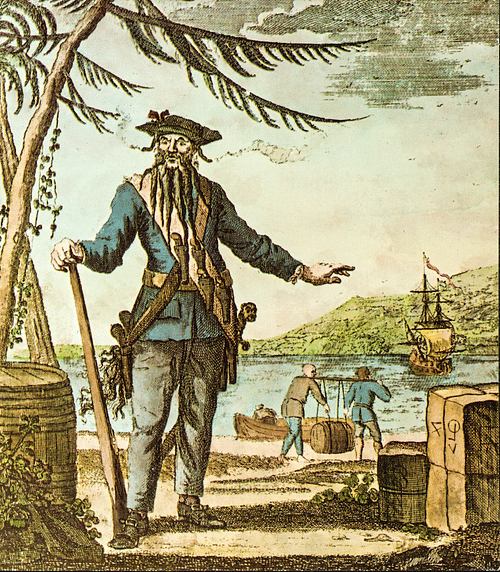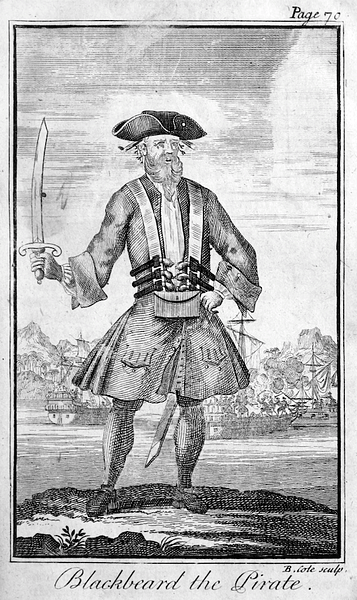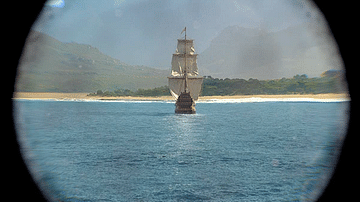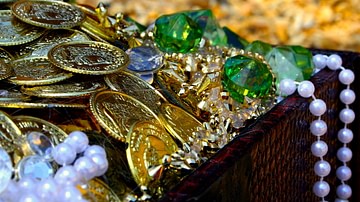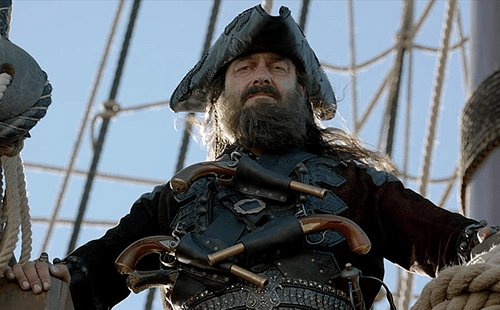
Blackbeard (d. 1718), otherwise known as Edward Teach (probably an assumed name), was an infamous English pirate who operated in the Caribbean and Atlantic during a surprisingly short career lasting just 15 months. With his long black beard tied with ribbons, lighted fuses under his hat, and bristling with pistols, Blackbeard’s name, reputation, and appearance were all calculated to freeze his victims with dreadful terror.
Thanks largely to a wildly exaggerated and mostly fictional portrait by the author Charles Johnson/Daniel Defoe (1660-1731), Blackbeard became the most colourful of all the pirates of the so-called Golden Age of Piracy. He is portrayed as a man with no morals or scruples, either towards his innocent victims or his own crews, and as a pirate who got his just deserts when he was killed in action against the Royal Navy, but then only after being struck down by five pistol shots and 20 sword cuts.
The Queen Anne’s Revenge
Nothing of Teach’s early life is known for certain except that he was born in Bristol, England, and spent his early years at sea raiding French and Spanish ships in Jamaican waters during the War of Spanish Succession (1701-1714). Edward Teach was most likely an assumed name, taken perhaps to hide a dark past. His real name may have been Edward Thatch (Thache) or Thatch Drummond, but these, too, could have been pseudonyms.
From September 1717, Teach served as a captain in the Bahamas under the British pirate Benjamin Hornigold. Their base, like many other pirates, was the island of New Providence. The two men, each commanding a vessel, attacked ships in the Caribbean and off the coast of North America. A notable capture was the Concorde, a French ship on its way to Martinique loaded with gold, coinage, gems, and other precious goods from trading posts in Africa. Teach took over this vessel in November 1717 near St. Vincent. He renamed it the Queen Anne’s Revenge. The now-pirate-ship had three masts and had seen service as a slave ship. It was fitted out with 40 cannons, which equalled the firepower of many naval vessels, and was used to raid the waters of Saint Vincent and Saint Kitts.
By early 1718, Teach had a total crew of 300-400 men. Teach was certainly an imposing figure thanks to his stature and black beard tied with black ribbons, and he was respected by his men. Witnesses record that discipline was tight amongst Teach’s pirate crew. Edward Teach, at least according to legend, had a particularly graphic version of the Jolly Roger flag, which was raised to secure instant surrender from victims. On Teach’s flag, a skeleton holds an hourglass in one hand and a spear pointing at a bleeding heart. These symbols reminded those on the ship being approached that their time was running out and death was the only outcome if any resistance was met.
After a few more captures, Teach sailed to North Carolina where he promised to give up piracy and he was awarded a pardon by the governor, Charles Eden. Many officials on the east coast of the American colonies turned a blind eye to piracy, either because they were involved in it themselves or because pirate booty was often cheaper than buying goods from legitimate traders. The lure of easy pickings from poorly armed merchant vessels meant that Teach did not, in fact, give up piracy, and in March 1718 he sailed the Queen Anne’s Revenge to the Bay of Honduras. There he managed to capture the Revenge of fellow British pirate Stede Bonnet (who was hanged later that same year). Following two more captures, Teach now commanded a fleet of four ships, and his attack on merchant shipping off the American coast continued through April. Teach’s second-in-command was Israel Hands, who captained the sloop Adventure. Having four ships meant that Teach could now raise his ambitions towards even bigger prizes.
The Carolina Coast
In May 1718, Teach successfully blockaded Charleston (aka Charles Town) in South Carolina for two weeks, attacking at least eight ships. Prisoners were released unharmed on payment of a ransom which included medicine, perhaps a necessity to treat syphilis amongst the crew. Sailing into the shallows of Beaufort Inlet on his way to North Carolina, the Queen Anne’s Revenge and one other ship were run aground on a sandbank, perhaps deliberately to reduce Teach's unusually large crew who required their share of booty taken. Revenge was returned to Bonnet, but Teach, not for the first time, took over all the loot carried by the fleet and sailed off in the remaining sloop. The stranded Queen Anne’s Revenge eventually sank, but it is very likely the wreck that was discovered and explored in the area from 1996. The wreck contained several artefacts creating strong links both with a ship of the period and Teach, most notably the unusually large number of cannons found.
Reaching Bath Towne, North Carolina, Teach was given another pardon by Governor Eden. He sold off his captured cargo and was even allowed to keep his sloop. The seemingly reformed pirate then married a 16-year-old daughter of a plantation owner and set up a home on Ocracoke Island. The pirate’s past soon caught up with him though, and a warrant of arrest was issued while he was visiting Philadelphia. Taking to the sea once more, Teach captured two French ships off Bermuda. He then returned to Bath Towne with a useful cargo of sugar and cocoa. Bribing the governor and officials with barrels of sugar, a court ruled that Teach had only rescued the cargo of a derelict ship and so was absolved from any charges of piracy. It may be that Teach was continuing in his pirate ways because he was allowed to do so by the governor thanks to regular and handsome bribes.
Teach’s Death
The Governor of Virginia, Alexander Spotswood, was, unlike his peer in neighbouring North Carolina, very keen to suppress piracy, as were many rich and powerful legitimate traders. When Teach’s former quartermaster testified to his captain’s illegal past deeds, two sloops were crewed by members of the British Royal Navy and sent to bring Teach to justice. These naval men set sail in November 1718 having been given the additional incentive of a 100 pounds reward for the capture of Teach, dead or alive.
By now, Teach had only around 20-25 men at his base, but he boarded his sloop and made ready to repel the attack force he saw crossing the shallows of Ocracoke Inlet. On 22 November, the British ships ran aground on a sandbank, and Teach, making good on his declaration that he would give no quarter and expect none in return, took the opportunity to fire his cannons at the sitting ducks. One ship was rendered unsailable following the broadside, but the other vessel, commanded by Lieutenant Robert Maynard, began to drift towards Teach’s ship. Maynard and most of his men hid below decks until the last moment. Teach’s men boarded the vessel, and the two groups met on deck with a flurry of pistol shots and sword blows. Teach and Maynard fought each other toe to toe. Teach was shot and wounded by a sword thrust in the neck, but still, the pirate battled on. It took five pistol shots and 20 sword cuts for Teach to fall, the final decapitating blow coming from a Highlander stood behind him. A local legend grew that the pirate’s headless corpse drifted three times around the sloop that had brought his downfall. Lieutenant Maynard stuck Teach’s head on the prow of his ship as a warning to others, as noted in his logbook entry for 3 January 1719:
Little wind & fair weather this day I anchored here [Williamsburg] from N Carolina in the Adventure Sloop Edward Thache formerly Master (a Pyrat) whose head I hung Under the Bowsprete of the Said Sloop in order to present it to ye Colony of Virginia and ye Goods & Effects of the Said Pyrat I Deliver’d to my Commanders Disposal.
(Cordingly, 200)
Those of Teach's men taken prisoner were tried and all hanged except for one acquittal and Israel Hands, who received a royal pardon thanks to his useful testimony against corrupt North Carolina officials.
For such an infamous pirate, Teach had enjoyed remarkably few successes. His career only lasted 15 months, and the prizes he took were hardly glittering treasure ships. Teach’s 23 captured ships was paltry compared to the over 400 taken by the Welsh pirate Black Bart Roberts (aka Bartholomew Roberts, c. 1682-1722) during his infamous career. Mundane stores of goods like sugar, cotton, and cocoa found at Teach’s base on Ocracoke Island after his death were collectively valued at only a couple of thousand pounds. There is no evidence that Teach had buried fantastic treasure after his captures. Nor is there any evidence that he had tortured or mistreated in any way his captives or that he was particularly nasty to his crew. In death, though, Teach would achieve far more than he had ever done in life. He swiftly became a legend, the very paragon of the bad, mad pirate that terrorized the High Seas.
The Blackbeard of Daniel Defoe
Only a few years after his death, Edward Teach was the subject of a biography alongside many other pirates in Daniel Defoe’s celebrated work, the General History of the Robberies and Murders of the Most Notorious Pyrates, compiled in the 1720s. The work was credited to a Captain Charles Johnson on its title page, but this is perhaps a pseudonym of Defoe’s (although scholars are still debating the issue and Johnson may have been a real, if entirely unknown pirate expert). A mix of fact and fiction - with no indication where one runs into the other - the book was a smash hit and has defined how pirates have been portrayed ever since. Teach as Blackbeard in Defoe’s work is described in lurid detail as a monster capable of almost any atrocity from rape to abominable executions. The author did clearly have access to official papers, records of trials, and journalistic contemporary accounts, and many statements have proven to be factual when corroborated with historical records. However, there are also countless exaggerations and pure inventions such as private conversations and speeches seemingly repeated ad verbatim. It is perhaps significant that Defoe was both a successful journalist and author, in other words, he knew exactly how to blend fact and fiction for maximum literary effect.

Defoe’s masterful portrait of Teach/Blackbeard includes this memorable physical description:
Captain Teach assumed the cognomen of Black-beard, from that large quantity of hair, which, like a frightful meteor, covered his whole face, and frightened America more than any comet that has appeared there a long time.
This Beard was black, which he suffered to grow of an extravagant length; as to breadth, it came up to his eyes; he was accustomed to twist it with ribbons, in small tails…and turn them about his ears. In time of action, he wore a sling over his shoulders, with three brace of pistols, hanging in holsters like bandoliers, and stuck lighted matches under his hat, which appearing on each side of his face, his eyes naturally looking fierce and wild, made him altogether such a figure, that imagination cannot form an idea of a fury, from Hell, to look more frightful.
(Defoe/Johnson, 84-5)
Blackbeard’s Amusements
Defoe, contrary to all evidence, describes Blackbeard as a veritable monster with a sadistic streak as wide as the wake of his ship. Not only is Blackbeard the scourge of innocents but even his crew were rarely safe from his fiendish entertainments. In one episode, the unstable captain locked himself and a number of the crew in the hold and burnt brimstone to all but suffocate themselves before the hatches were opened at the last minute.
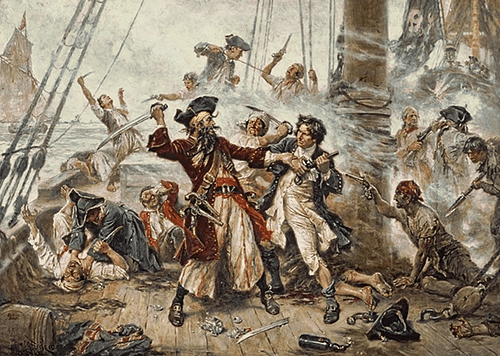
Blackbeard once marooned 15 crewmen on a small barren rock near Tortola in the British Virgin Islands, known to mariners thereafter as The Dead Man’s Chest (now called Dead Chest Island). Here, Blackbeard left the men with a chest of treasure and a cutlass and a bottle of rum each. The captain hoped the men would soon kill each other, no doubt, in an attempt to claim a greater share of the booty for himself, but in this, he was disappointed, since returning to the rock one month later, all 15 men were still living.
In another ‘game’, Blackbeard took out two pistols, blew out the candle, and shot Israel Hands under the cabin table after the latter had fallen asleep playing cards. Shooting his second-in-command in the knee with one ball, Blackbeard missed with the other. When asked by his crew why he had done such a thing, the pirate replied that "if he did not now and then kill one of them, they would forget who he was". (Defoe/Johnson, 84).
Blackbeard is given a prodigious sexual appetite with countless lustful encounters and no fewer than 14 wives whom he had a habit of prostituting out to his men. In contrast, one governor noted in January 1718 that Teach "it’s said has a wife and children in London" (quoted in Cordingly, 71). Despite the gap between fact and fiction, the image of Blackbeard the debauched pirate captain as presented by Defoe was repeated in later fictional works, notably Robert Louis Stevenson’s Master of Ballantrae, published in 1889. The notorious pirate was the subject of a popular London musical play at the end of the 19th century, James Cross’ Blackbeard, or the Captive Princess. By the 20th century, and although portrayed as an utter villain in the popular 1952 film Blackbeard the Pirate, Blackbeard had become so outrageous he was largely restricted to being a figure of fun in comedy films like Disney’s Blackbeard’s Ghost of 1968.

